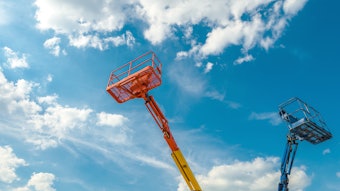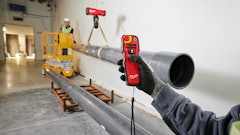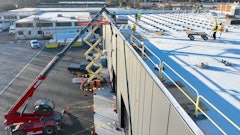
Industry veteran and subject matter expert Ebbe Christensen, president and CEO of Ruthmann-Reachmaster, presented a webinar on compact lifts, their applications and safety factors.
Compact lifts
Think about a high reach task inside a building courtyard or a task that requires you to set up on a sloped surface. How are workers going to access their work at height? There’s a good chance the solution is a compact lift.
A compact lift, also known as a spider lift or compact crawler, is a type of mobile elevating work platform (MEWP) designed for accessing hard-to-reach areas. It is characterized by its versatile and flexible nature, making it ideal for various applications in construction, maintenance and other industries. Compact lifts have a long, narrow body with swing-out outriggers and are lightweight compared to other types of lifts that reach similar heights. This allows them to access narrow spaces, confined areas and locations with limited accessibility, such as indoor environments or uneven terrain.
Most lifts are designed as a combination between a set of two articulating fixed arms, a telescoping boom and a jib that can be maneuvered independently. This concept combined with basket rotation enables the lift to reach up, over and around obstacles, providing increased versatility and flexibility.
One distinguishing characteristic of a compact lift is the stabilization features. They all have extendable outriggers that can be adjusted individually to accommodate maximum setup environment flexibility while at the same time provide sufficient and safe stability.
With the outriggers (not counterweight) being the main offset for operational reach, setting up the outriggers correctly is the most single important function to setup the units. For that reason, most brands offer automatic stabilization and leveling on both even or uneven or sloping surfaces. Most brands have sensor technology that will monitor stability during operation and in case of any instability, shut the unit down.
These lifts are available with either a tracked-based or wheeled-based configuration, and while they are drivable when in a stowed position, they require outriggers to be set to elevate the work platform and are considered a type 1 or nondrivable MEWP.
Applications
Due to their compact size and low ground pressure, compact lifts are suitable for both indoor and outdoor applications. They can operate on surfaces with limited and/or strict weight limitations as well as delicate flooring surfaces without causing damage. Other comparable work height MEWPs cannot do this as they are several times heavier.
These lifts are available in with various power options, including electric (batteries), diesel and hybrid models. Electric models are ideal for indoor use due to their zero-emission and low-noise operation, while diesel or hybrid models add greater flexibility for outdoor applications and overall utilization.
Compact lifts are designed for highly controlled maneuverability, often operating within confined areas and right next to delicate and breakable surfaces like glass and stone walls. The narrow dimensions and advanced control systems allow operators to navigate through tight spaces, around obstacles and access elevated areas safely.
For a MEWP category that can reach between 35 feet to 170 feet, these machines are, for the most part, easy to transport but are by design somewhat fragile compared to other MEWPs.
Safety
As with all MEWPs, qualified persons are required to perform all of the related task with their use. MEWP operators, ground personnel and those performing maintenance or repairs must be properly trained and assessed as qualified prior to the start of task.
Compliance with ANSI/SAIA A92.22 safe use and A92.24 training standards is a must. While the standards will provide general guidance, machine specific familiarization and reading and understanding the machine’s operator manual is needed to safely perform required tasks. MEWPs can have different controls, safety devices and operating characteristics that must be identified before operating any MEWP. Compact lifts have large outriggers, some self-leveling, and others not, and many machines are equipped with remote controls that require an operator to obtain machine specific familiarization.
When using a MEWP with tracks, it is important to check the track condition for tension. You don’t want the tracks to come off when you are trying to position the machine. The operator manual will guide you on what to look for and how to adjust when necessary. Another important fact is that when raising the lift with the outriggers, you must raise the tracks off the ground 6 to 12 inches, depending on the manufacturer recommendations. Additionally, ensure the chassis is level.
Compact lifts are becoming increasingly popular and available option in rental fleets. These machines are well designed and manufactured to allow high reach access into areas where a MEWP could not previously access.
























